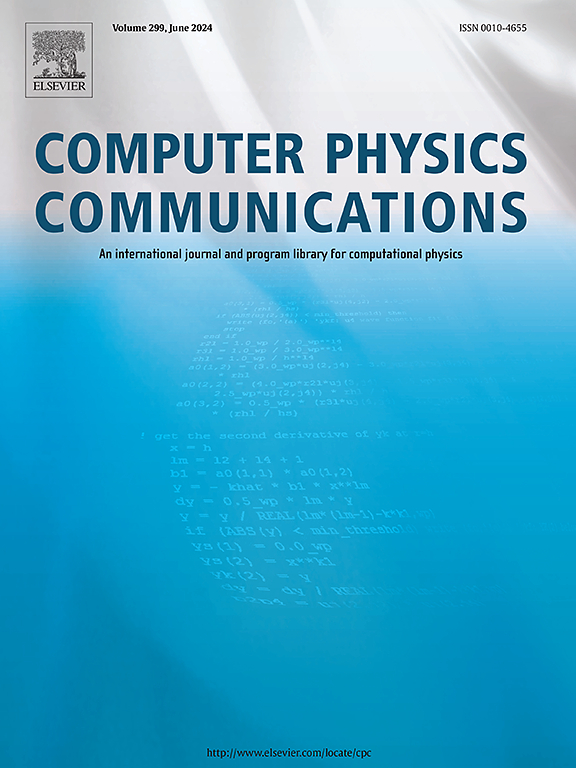Evaluation and sensitivity analysis of the FitzHugh–Nagumo model parameters for studying electrical signals generated by different biological tissues
IF 3.4
2区 物理与天体物理
Q1 COMPUTER SCIENCE, INTERDISCIPLINARY APPLICATIONS
引用次数: 0
Abstract
Accurate modeling of cardiac electrical activity is essential for developing diagnostic and therapeutic technologies. This study presents a parameter evaluation of a modified FitzHugh–Nagumo (FHN) model to reproduce the specific waveforms generated by different cardiac tissues, such as the sinoatrial node, atria, atrioventricular node, Purkinje fibers, and ventricles. Through a systematic sensitivity analysis, the influence of key parameters on waveform features such as amplitude, duration, and frequency is identified, allowing precise calibration for each tissue type. These parameter sets were then integrated into a multi-compartment model and implemented in a two-dimensional (2D) spatial domain using COMSOL Multiphysics, following the framework of Sovilj et al. The simulations successfully replicated electrocardiographic components—including the P wave, QRS complex, and T wave—by combining spatially distributed signals with physiologically representative dynamics. Rather than proposing a new model, this work validates a methodology for tuning and applying simplified excitable models to simulate realistic cardiac behavior efficiently. The approach offers potential applications in the design of low-power wearable devices and supports the development of personalized monitoring systems. Future work will extend this methodology to other excitable tissues and explore its use in modeling pathological conditions or structural constraints, providing a flexible platform for evaluating requirements in next-generation bioelectronic devices.
FitzHugh-Nagumo模型参数在不同生物组织电信号研究中的评价及灵敏度分析
心脏电活动的准确建模对于发展诊断和治疗技术至关重要。本研究提出了一种改进的FitzHugh-Nagumo (FHN)模型的参数评估,以再现窦房结、心房、房室结、浦肯野纤维和心室等不同心脏组织产生的特定波形。通过系统的灵敏度分析,确定了关键参数对振幅、持续时间和频率等波形特征的影响,从而可以对每种组织类型进行精确校准。然后,这些参数集被整合到一个多室模型中,并按照Sovilj等人的框架,使用COMSOL Multiphysics在二维空间域中实现。模拟成功地复制了心电图成分,包括P波、QRS复合体和T波,通过将空间分布信号与生理代表性动力学相结合。这项工作不是提出一个新的模型,而是验证了一种调整和应用简化的可兴奋模型来有效地模拟现实心脏行为的方法。该方法为低功耗可穿戴设备的设计提供了潜在的应用,并支持个性化监控系统的开发。未来的工作将把这种方法扩展到其他可兴奋组织,并探索其在病理条件或结构约束建模中的应用,为评估下一代生物电子器件的需求提供一个灵活的平台。
本文章由计算机程序翻译,如有差异,请以英文原文为准。
求助全文
约1分钟内获得全文
求助全文
来源期刊

Computer Physics Communications
物理-计算机:跨学科应用
CiteScore
12.10
自引率
3.20%
发文量
287
审稿时长
5.3 months
期刊介绍:
The focus of CPC is on contemporary computational methods and techniques and their implementation, the effectiveness of which will normally be evidenced by the author(s) within the context of a substantive problem in physics. Within this setting CPC publishes two types of paper.
Computer Programs in Physics (CPiP)
These papers describe significant computer programs to be archived in the CPC Program Library which is held in the Mendeley Data repository. The submitted software must be covered by an approved open source licence. Papers and associated computer programs that address a problem of contemporary interest in physics that cannot be solved by current software are particularly encouraged.
Computational Physics Papers (CP)
These are research papers in, but are not limited to, the following themes across computational physics and related disciplines.
mathematical and numerical methods and algorithms;
computational models including those associated with the design, control and analysis of experiments; and
algebraic computation.
Each will normally include software implementation and performance details. The software implementation should, ideally, be available via GitHub, Zenodo or an institutional repository.In addition, research papers on the impact of advanced computer architecture and special purpose computers on computing in the physical sciences and software topics related to, and of importance in, the physical sciences may be considered.
 求助内容:
求助内容: 应助结果提醒方式:
应助结果提醒方式:


